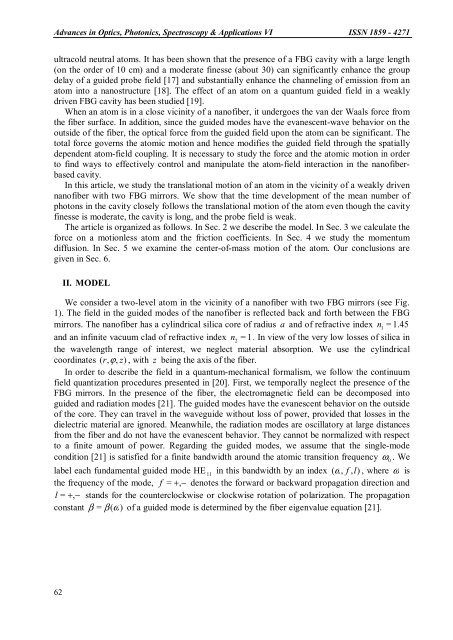Nhng tin b trong Quang hc, Quang ph và ng dng VI ISSN 1859 - 4271
Nhng tin b trong Quang hc, Quang ph và ng dng VI ISSN 1859 - 4271
Nhng tin b trong Quang hc, Quang ph và ng dng VI ISSN 1859 - 4271
Create successful ePaper yourself
Turn your PDF publications into a flip-book with our unique Google optimized e-Paper software.
Advances in Optics, Photonics, Spectroscopy & Applications <strong>VI</strong> <strong>ISSN</strong> <strong>1859</strong> - <strong>4271</strong>ultracold neutral atoms. It has been shown that the presence of a FBG cavity with a large le<strong>ng</strong>th(on the order of 10 cm) and a moderate finesse (about 30) can significantly enhance the groupdelay of a guided probe field [17] and substantially enhance the channeli<strong>ng</strong> of emission from anatom into a nanostructure [18]. The effect of an atom on a quantum guided field in a weaklydriven FBG cavity has been studied [19].When an atom is in a close vicinity of a nanofiber, it undergoes the van der Waals force fromthe fiber surface. In addition, since the guided modes have the evanescent-wave behavior on theoutside of the fiber, the optical force from the guided field upon the atom can be significant. Thetotal force governs the atomic motion and hence modifies the guided field through the spatiallydependent atom-field coupli<strong>ng</strong>. It is necessary to study the force and the atomic motion in orderto find ways to effectively control and manipulate the atom-field interaction in the nanofiberbasedcavity.In this article, we study the translational motion of an atom in the vicinity of a weakly drivennanofiber with two FBG mirrors. We show that the time development of the mean number of<stro<strong>ng</strong>>ph</stro<strong>ng</strong>>otons in the cavity closely follows the translational motion of the atom even though the cavityfinesse is moderate, the cavity is lo<strong>ng</strong>, and the probe field is weak.The article is organized as follows. In Sec. 2 we describe the model. In Sec. 3 we calculate theforce on a motionless atom and the friction coefficients. In Sec. 4 we study the momentumdiffusion. In Sec. 5 we examine the center-of-mass motion of the atom. Our conclusions aregiven in Sec. 6.II. MODELWe consider a two-level atom in the vicinity of a nanofiber with two FBG mirrors (see Fig.1). The field in the guided modes of the nanofiber is reflected back and forth between the FBGmirrors. The nanofiber has a cylindrical silica core of radius a and of refractive index n1= 1.45and an infinite vacuum clad of refractive index n2= 1. In view of the very low losses of silica inthe wavele<strong>ng</strong>th ra<strong>ng</strong>e of interest, we neglect material absorption. We use the cylindricalcoordinates ( r,ϕ , z), with z bei<strong>ng</strong> the axis of the fiber.In order to describe the field in a quantum-mechanical formalism, we follow the con<s<stro<strong>ng</strong>>tro<strong>ng</strong></stro<strong>ng</strong>>>tin</s<stro<strong>ng</strong>>tro<strong>ng</strong></stro<strong>ng</strong>>>uumfield quantization procedures presented in [20]. First, we temporally neglect the presence of theFBG mirrors. In the presence of the fiber, the electromagnetic field can be decomposed intoguided and radiation modes [21]. The guided modes have the evanescent behavior on the outsideof the core. They can travel in the waveguide without loss of power, provided that losses in thedielectric material are ignored. Meanwhile, the radiation modes are oscillatory at large distancesfrom the fiber and do not have the evanescent behavior. They cannot be normalized with respectto a finite amount of power. Regardi<strong>ng</strong> the guided modes, we assume that the si<strong>ng</strong>le-modecondition [21] is satisfied for a finite bandwidth around the atomic transition frequency ω0. Welabel each fundamental guided mode HE 11in this bandwidth by an index ( ω , f , l), where ω isthe frequency of the mode, f = +, − denotes the forward or backward propagation direction andl = +,− stands for the counterclockwise or clockwise rotation of polarization. The propagationconstant β = β ( ω)of a guided mode is determined by the fiber eigenvalue equation [21].62















